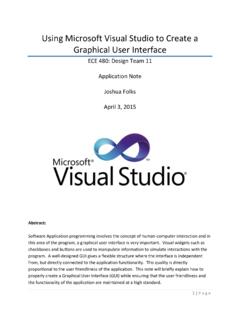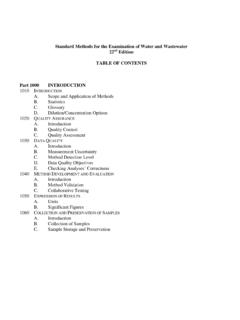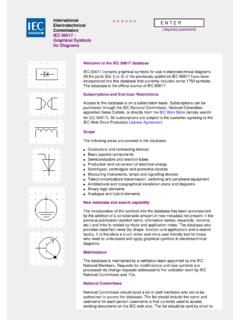Transcription of 12 TABULATION AND GRAPHICAL REPRESENTATION OF …
1 UNIT 12 tabulation and graphical representation of DATA Structure Introduction Objectives Meaning of Data Nature of Data Qualitative and Quantitative Data Continuous and Discrete Data Primary and Secondary Data 1 Measurement Scales Meaning of Statistics Need and Importance of Statistics Importance of the Organisation of Data Presentation of Data in a Sequence Grouping and TABULATION of Data 1 GRAPHICAL REPRESENTATION of Data Types of GRAPHICAL REPRESENTATION of Data Histogram Bar Diagram or Bar Graph Frequency Polygon Cumulative Frequency Curve or Ogive Let Us Sum Up Unit-end Exercises ! Points for Discussion Answers to Check Your Progress 1 Suggested Readings I INTRODUCTION In Block 11, you have studied about the learner's evaluation. For learner's evaluation, we usually administer a number of tests on all students of the class and scores are given in their answer-scripts. Often these are used as such, without interpreting them.
2 If you have to interpret the scores, you must learn to tabulate them in a meaningful way and calculate various statistics from the same. In this Unit, you will study about the meaning and nature of data; the need and importance of statistics; the TABULATION of data in a meaningful way and various types of GRAPHICAL REPRESENTATION to make the data easily comprehendible. Various types of statistics and the methods of their computation are being discussed in the subsequent units of this block itself. ' OBJECTIVES After going through this unit, you will be able to: understand the meaning and nature of data; distinguish between the four measurement scales; 5 Techniques of understand the need, importance and meaning of statistics; appreciate the importance of the organisation of data; tabulate the data obtained by you in the classroom in a meaningful way; app~teciate the advantages of GRAPHICAL REPRESENTATION of data; use appropriate graphic REPRESENTATION , for the data obtained by you in the classroom; and interpret the data given in the form of GRAPHICAL REPRESENTATION .
3 MEANING OF DATA You might be reading a newspaper regularly. Almost every newspaper gives the minimum and the maximum temperatures recorded in the city on the previous day. It also indicates the rainfall recorded, and the time of sunrise and sunset. In your school, you regularly take attendance of children and record it in a register. For a patient, the doctor advises recording of the body temperature of the patient at regular intervals. If you record the minimum and maximum temperature, or rainfall, or the time of sunrise and sunset, or attendance of children, or the body temperature of the patient, over a period of time, what you are recording is known as data. Here, you are recording the data of minimum and maximu& temperature of the city, data of rainfall, data for the time of sunrise and sunset, and the data pertaining to the attendance of children. As an example, the class-wise attendance of students, in a school, is as recorded in Table Table Class-wise Attendance of Students Class No.
4 Of Students Present VI 42 VII 40 VIII XI. XI1 30 Total 256 Table gives the data for class-wise attendance of students. Here the data comprise 7 observations in all. These observations are, attendance fgr class VI, VII, and so on. So, data refers to the set of observations, values, elements or objects hder consideration. The complete set of all possible elements or objects is called a population. Each of the elements is called a piece of data. Data alsd refers to the known facts or things used as basis for inference or reckoning facts, information, material to be processed or stored. NATURE OF DATA For understanding the nature of data, it becomes necessary to study about the various forms of ,$ data, as shown below : Qualitative and Quantitative Data Continuous and Discrete Data IL Primpry and Secondary Data Qualitative and Quantitative Data TABULATION and GRAPHICAL REPRESENTATION of Data Let us consider a set of data given in Table Table Management-wise Number of Schools Management No.
5 Of Schools Government 4 Local Body Private Aided Private Unaided - - - - - Total 24 1 In Table , number of schools have been shown according to the management of schools. So the schools have been classified into 4 categories, namely, Government Schools, Local Body Schools, Private Aided Schools and Private Unaided Schools. A given school belongs to any one of the four categories. Such data is shown as Categorical or Qualitative Data. Here the category or the quality referred to is management. Thus categorical or qualitative data result from information which has been classified into categories. Such categories are listed alphabetically or in order of decreasing frequencies or in some other conventional way. Each piece of data clearly belongs to one classification or category. We frequently come across categorical or qualitative data in the form of schools categorised according to Boys, Girls and Co-educational; Students' Enrolment categorised according to SC, ST, OBC and 'Others'; number of persons employed in various categories of occupations, and so on.
6 Let us consider another set of data given in Table \ Table Number of Schools according to Enrolment Enrolment No. of Schools 1 Above 300 4 Total 45 In Table , number of schools have been shown according to the enrolment of students in I the school. Schools with enrolment varying in a specified range are grouped together, there are 15 schools where the students enrolled are any number between 51 and 100. As the grouping is based on numbers, such data are called Numerical or Quantitative Data. Thus, numerical or quantitative data result from counting or measuring. We frequently come across numerical data in newspapers, advertisements etc. related to the temperature of the cities, cricket averages, incomes, expenditures and so on. Continuous and Discrete Data Numerical or quantitative data may be continuous or discrete depending on the nature of the elements or objects being observed. T,et us consider the Table depicting the heights of students of a class. Statistical Tezhniques of Analysis Table Heights of Students of a Class Height No.
7 Of Students 4'8"- 4' 10" 2 5'8"- 5'10" 2 * Total 4 1 Tablq gives the data pertaining to the heights of students of a class. Here the element under observation is the height of the students. The height varies from 4' 8" to 5' 10". The height of an individual may be anywhere from 4' 8" to 5' 10". Two students may vary by almost zero inch height. Even if we take two adjacent points, say 4' " and 4' " there may be several values between the two points. Such data are called Continuous Data, as the heigbt is continuous. Continuous Data arise from the measurement of continuous attributes or vdriables, in which individual may differ by amounts just approaching zero. Weights and heig$ts of children; temperature of a body; intelligence and achievement level of students, etc. are the examples of continuous data. Let ds consider Table showing the number of students enrolled and the number of schools accotding to enrolment. Let us,consider the enrolment of 2 schools as 60 and 61.
8 Now in betdeen 60 and 61, there cannot be any number, as the enrolment will always be in whole numbers. Thus there is a gap of one unit from 60 to 61. Such data, where the elements being observed have gaps are called Discrete Data. Discbete Data are characterised by ,gilps in the scale, for which no real values may ever be found. Such data are usually expressed in whole numbers. The size of a family, enrolment of children, number of books etc. are the examples of discrete data. Generally data arising from meagurement are continuous, while data arising from counting or arbitrary classification are discrete. The achievement scores of students, though presented in discrete form may be considered to constitute continuous data, since a score of 24 represents any point between and Actually achievement is a continuous attribute or variable. All peasurements of continuous attributes are approximate in character and as such do not prodide a basis for distinguishing between continuous and discrete data.
9 The distinction is madie on the basis of variable being measured. 'Height' is a continuous variable but number of chilqren would give discrete data. Primary and Secondary Data The data collected by or on behalf of the person or people who are going to make use of the data refers to primary data. For example, the attendance of children, the result of examinations conducted by you are primary data. If you contact the parents of the children and ask about theit. educational qualifications to relate them to the performance of the children, this also give+ primary data. Actually, when an individual personally collects data or information per$ining to an event, a definite plan or design, it refers to primary data. * Sodetimes an investigator may use the data already collected by you, such as the school attehdance of children, or performance of students in various subjects. etc, for hislher study, the9 the data are secondary data. The data used by a person or people other than the people by whom or for whom the data were collected refers to secondary data.
10 For many reasons we may have to use secondary data, which should be used carefully, since the data could have beeh collected with a purpose different from that of the investigator and may lose some detail or may not be fully relevant. For using secondary data, it is always useful to know : d a) how the data have been collected and processed; b) the accuracy of data; TalmhtionradGrppllicaS * RepEwaIalim d Data ' c.) how far the data have been summarised; d) how comparable the data are with other tabulations; and e) how to interpret the data, especially when figures collected for one purpose are used for another purpose. -- " .- _ " ^I1 -- ~IL< b 1 , &I !>1(*>5,\~~ MEASUREMENT SCALES Measurement refers to the assignment of numbers to objects and events according to logical acceptable rules. The numbers have many properties, such as identity, order and additivity. If we can legitimately assign numbers in the describing of objects and events, then the properties of numbers should be applicable to the objects and events.









